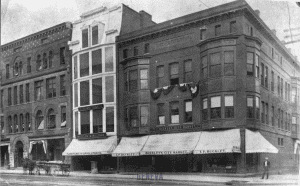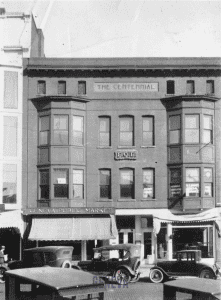Commemorating a Milestone: The Centennial Building
By Becky Chapin, Archivist
John Francis “Frank” Dwyer came to Geneva from Massachusetts in 1885 to attend Hobart College. He joined the Hobart baseball team as pitcher and made an impression on the professional league. In 1888, he was recruited to the minor league Chicago Maroons team with whom he played for one season, joining the Chicago White Stockings for the following season. Frank would leave before graduation in 1890 to start the season with Chicago, though he served as Hobart baseball’s trainer and occasionally pitched for the team in his final year.
Frank played for several teams, finishing out his career with the Cincinnati Reds from 1892 to 1899. Throughout this time, he continued to live in Geneva when not training or on the road. In 1891, he married Margaret Broderick and they lived with her family on Castle Street. Margaret co-owned Broderick & Co, a millinery, on Seneca Street with her mother and sister.

The Centennial in the 1910s with TF Buckley as the main tenant. Note: The Wheeler & Williams building was constructed at the same time but is now gone.
In 1895, Frank purchased the property on the corner of Castle and Elm Streets, 118 Castle St., for $2,800. In 1896-7, he demolished the building to construct the new Dwyer block (118-120 Castle). The experience must have been rewarding for Frank who then purchased a lot on Geneva Street. Following a massive fire in the Hill Block and neighboring buildings in 1902 on the corner of Castle and Geneva Streets, Frank then purchased the corner lot which would give him one large lot to put together.
In 1906, Frank commissioned the construction of a large building which would house stores on the first floor, offices on the second, and the Knights of Columbus on the third. The construction coincided with the Centennial celebration of Geneva becoming a village during the week of May 14, 1906. To commemorate the event, Frank had “The Centennial” pressed into the block at the top of the building that would become 64-68 Castle Street (this would become 68-70 later on and is different from today).
His first tenant would be TF Buckley who was already running a successful grocery store on Exchange Street. Castle Street would be Buckley’s second location and included a meat market on the west side and grocery on the east side of the building. Buckley occupied the building’s first floor until the early 1920s. After that, the two sides of the storefront were occupied by different businesses. Additionally, Frank served as president of the Roll-O Manufacturing Company which manufactured a variety of games out of the Centennial building including golf, automobile race, and baseball board games.
Frank sold the building at 118 Castle Street to Mike Calabreese (possibly a misspelling of Calabrese) and opened Dwyer’s Coal Yard at the base of Castle Street, also called Dwyer Block.
In 1924, the Geneva Aerie of Eagles purchased the Centennial building for $50,000. The Knights of Columbus moved to a new home and the Eagles took over the third floor. At the time, the American Express Company office and Cooper and Sons’ market were tenants on the first floor. In 1928, the Eagles remodeled the building, painting, replastering, and installing a new, larger boiler. At some point, the Eagles organization shuttered in Geneva and the building was sold to the Geneva Trust Company.
In 1943, Victor AuClair purchased it from the Trust Company and planned to move his ‘penny arcade’ to the block. Instead, he seems to have opened an appliance store called the Easy Washer Shop. His shop and the Fitzgerald Television shop occupied the first floor, and the Geneva Federation of Labor occupied the third floor. After being hit by several small fires over the years, in 1952 a larger fire in the cellar did damage totaling about $10,000. At the time, Victor had a restaurant on the first floor along with a BF Goodrich store on the other side. Victor then sold it to Ralph Dimick, with the building being known colloquially as the AuClair Block.
Ralph operated his company, Dimick Land Co., there for three years before selling the building back to Victor. Eventually he sold it to the Carpenters’ Pension Fund which also occupied the third floor along with several other labor unions. In 1971, the group renovated the building and installed a new front of anodized aluminum (see photograph).
A windstorm in 1972 damaged the roof of the building, leaving the sidewalk strewn with fallen brick but the building remains relatively the same as it did when Frank first built it.
This article was brought to you in part by our supporters. Be our partner in telling Geneva’s stories by becoming a Historic Geneva supporter.

